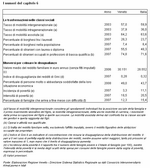6. The figures tell the story
|
The profound changes that have come about in the economic and employment sphere in Italy since the Second World War, first industrialisation and then tertiarisation, have led to significant changes in Veneto's social structure.
In 2007, almost 40% of people employed in Veneto belonged to the working class, 35% to the white collar middle class, 18% to the lower middle class, and just over 7% to the upper middle class. Like in other small business areas, the biggest group is the urban blue collar working class, while the upper middle class and the white collar middle class are the smallest. Despite the major transformations in the composition of social classes, both in Italy and in Veneto about 35% of children find themselves in the same social and occupational position as their father, while 30% managed to climb the social ladder. The white collar middle class and the urban blue collar working class are the least open. In Veneto though, social advancement depends less on family background, meaning more equal opportunities for success. Foreign residents have great difficulty climbing the social ladder; even if they have a high level of education, foreign residents in Veneto still mostly do lower level jobs. The children of foreign residents, however, aspire to a different future. Encouraging social mobility is one tool to bridge social inequalities and divides, also in terms of income. In Italy the income of the wealthiest 20% of families is more than five times that of the poorest 20%; in Europe on average this proportion is 4.8 times. In Veneto the income gap is more contained and on average families declare that they are more satisfied with their financial situation, as they have to endure less hardships in daily life. There is a much lower percentage of poor families too (3.3% compared to 11.1% of Italian families). (Chapter 6 in figures) |
|
Data processed by the Statistics Office of Regione Veneto are collective property; reproduction of this material is authorised for non-commercial purposes only, provided the source "Regione Veneto - Regional Statistics System Management" is acknowledged.
English translation by the University of Padova Language Centre.



